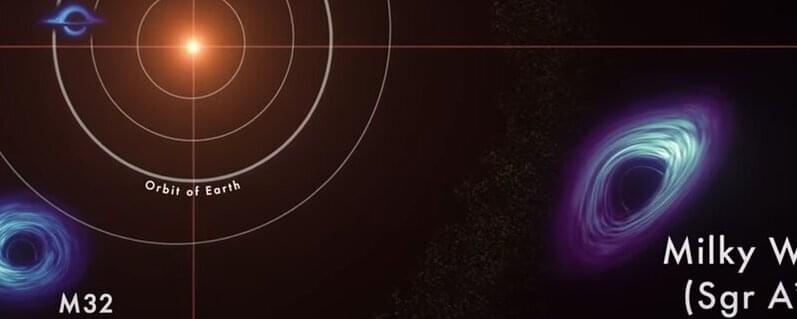May 2, 2023
Detecting Dark Photons with Radio Telescopes
Posted by Saúl Morales Rodriguéz in category: cosmology
A search for rare interactions between dark photons and regular matter provides constraints on the properties of ultralight dark matter.
A search for rare interactions between dark photons and regular matter provides constraints on the properties of ultralight dark matter.
A new model describes the range of forces and torques that light in a fiber can impart on dielectric particles nearby, even in the absence of helical light polarization.
Aliens on nearby stars could detect Earth through radio signals leaked from the planet, new research suggests.
Scientists from The University of Manchester and the University of Mauritius used crowd sourced data to simulate radio leakage from mobile towers to determine what alien civilizations might detect from various nearby stars, including Barnard’s star, six light years away from Earth.
The research, published in the Monthly Notices of the Royal Astronomical Society journal, found that only more technologically advanced civilizations would be able to detect the current levels of mobile tower radio leakage from Earth. However, as most alien civilizations are likely to have more sensitive receiving systems and as we move towards more powerful broadband systems on Earth, the detectability of humans from other intelligent beings will become more and more likely.
In the ceaseless pursuit of energy-efficient computing, new devices designed at UC Santa Barbara show promise for enhancements in information processing and data storage.
Researchers in the lab of Kaustav Banerjee, a professor of electrical and computer engineering, have published a new paper describing several of these devices, “Quantum-engineered devices based on 2D materials for next-generation information processing and storage,” in the journal Advanced Materials. Arnab Pal, who recently received his doctorate, is the lead author.
Each device is intended to address challenges associated with conventional computing in a new way. All four operate at very low voltages and are characterized as being low leakage, as opposed to the conventional metal-oxide semiconductor field-effect transistors (MOSFETs) found in smartphones that drain power even when turned off. But because they are based on processing steps similar to those used to make MOSFETs, the new devices could be produced at scale using existing industry-standard manufacturing processes for semiconductors.

A Cornell-led collaboration harnessed chemical reactions to make microscale origami machines self-fold—freeing them from the liquids in which they usually function, so they can operate in dry environments and at room temperature.
The approach could one day lead to the creation of a new fleet of tiny autonomous devices that can rapidly respond to their chemical environment.
Continue reading “Self-folding origami machines powered by chemical reactions” »
Harmful PFAS chemicals can now be detected in many soils and bodies of water. Removing them using conventional filter techniques is costly and almost infeasible. Researchers at the Fraunhofer Institute for Interfacial Engineering and Biotechnology IGB are now successfully implementing a plasma-based technology in the AtWaPlas joint research project.
Contaminated water is fed into a combined glass and stainless steel cylinder where it is then treated with ionized gas, i.e., plasma. This reduces the PFAS molecular chains, allowing the toxic substance to be removed at a low cost.
Per-and polyfluoroalkyl substances (PFAS) have many special properties. As they are thermally and chemically stable as well as resistant to water, grease and dirt, they can be found in a large number of everyday products: Pizza boxes and baking paper are coated with them, for example, and shampoos and creams also contain PFAS. In industry they serve as extinguishing and wetting agents, and in agriculture they are used in plant protection products.

As freshwater scarcity affects millions worldwide, scientists and engineers have looked for new ways of filtering unwanted metals and minerals out of water while retaining those elements for re-use elsewhere.
Capacitive deionization (CDI), a technology in which a membrane made from electrode materials removes metal ions from water, has proved a promising technique for such next-generation water filters. Researchers from University of Chicago and Argonne National Laboratory envisioned the technique could be made even more efficient if they modified the molecular surface of the electrodes.
Continue reading “New technology more efficiently removes heavy metals from water” »

Dr. Ralph W. Moss and his son Ben discuss the anti-cancer properties and challenges of consuming green tea as a part of a healthy diet.
Program Notes:
The company will pause hiring soon, and expects up to 30% of non-customer-facing roles will be replaced by automation in the next five years.

https://youtube.com/watch?v=jU1DsipURcM
A new NASA animation highlights the “super” in supermassive black holes. These monsters lurk in the centers of most big galaxies, including our own Milky Way, and contain between 100,000 and tens of billions of times more mass than our sun.
“Direct measurements, many made with the help of the Hubble Space Telescope, confirm the presence of more than 100 supermassive black holes,” said Jeremy Schnittman, a theorist at NASA’s Goddard Space Flight Center in Greenbelt, Maryland. “How do they get so big? When galaxies collide, their central black holes eventually may merge together too.”
Continue reading “NASA animation sizes up the universe’s biggest black holes” »
